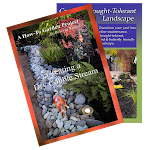
Remember the children’s song “Rain, rain, go away, come back another day!”? Well, it looks like we have to change the lyrics to “rain, rain, come again!” California’s water supply is short.
We did get a rather large amount of rain over a two day period last month...said to have blown in from a bigger storm overseas. When I heard that rain was coming I decided that this time I would catch it and use it for my garden... why not?
I went over to The Home Depot and purchased two 55 gallon plastic trash bins with lids ($13.89 each), and two 20’x 4” ABS (plastic) drains. I removed the downspout from my gutters and attached the ABS drain (using wire to hold it in place), and then positioned the trash bins under the spout with the drains leading into them. The rain started somewhere after midnight. By 8:00 a.m. the next morning my trash bins were overflowing, I could have filled 10 of them!
I learned something important: I could catch enough water during the winter months to water my entire garden all summer. That’s the idea. Implementing a system that makes it worthwhile however seems to be a little more complicated, namely, hooking up a pressurized irrigation system to the water tanks. The trash bins that I used were fine to catch the water, but now I have to use a bucket to move the water from the bin to my watering can. I use the water only for my potted plants which are close to the source...otherwise I would have to haul it to the back of the yard and that’s a lot of work.
Emigh Hardware sells an 80 gallon holding tank with a screen on the top and a hose spigot on the bottom. Attaching a hose makes it much easier to water plants, a more ideal solution. Still, any type of irrigation system requires water pressure to force the water out of the ends of the pipe. This pressure normally comes from the water main and therefore would have to be supplanted by a pump in my water barrel system.
A client of mine contacted Gutterglove Company who installs special gutters that filter water caught in gutters and then dumps it into a holding tank. The tank sizes vary depending on how much you pay. Unfortunately, the representative from Gutterglove had no idea how to hook up a pressurized irrigation system with a hose. My client is contacting another company, and hopefully they will know how to do it.
Many people are starting to implement their own gray water systems. A system of using use the recycled household water (showers and sinks) to water their garden. The water also goes into a tank (instead of the sewer system) and gets some filtration, and then is pumped out to the garden. These systems are used for particular areas of the garden.
All of these methods are worth checking into. Next month I’ll post the findings on hooking up a system to irrigate, using pressure, from caught water. For now, consider buying a holding tank from the hardware store that will allow you to catch water and hook up a hose. It’s very satisfying to water your garden from water that came naturally, and not from the usual source that you paid for!












